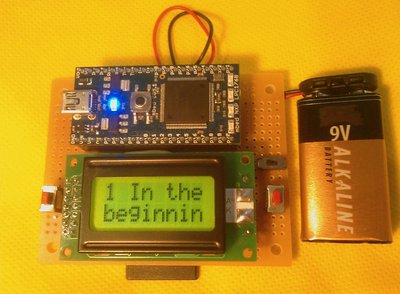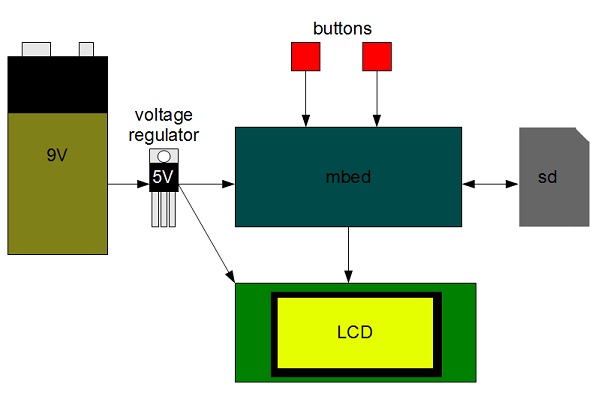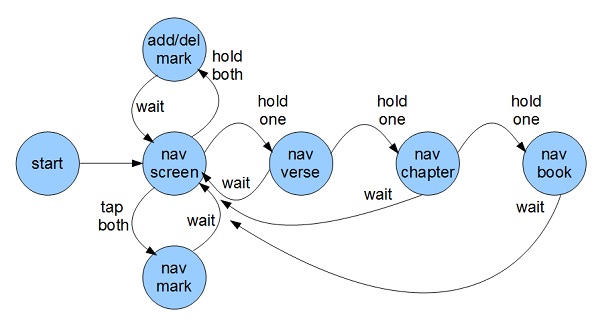eBible
See Program http://mbed.org/users/davervw/programs/eBible/lnaue6
See Documentation http://mbed.org/users/davervw/notebook/ebible-documentation/
Abstract
The eBible is an eBook prototype on the mbed microcontroller programmed to navigate the entire King James Version of the Bible, the famous English translation completed 400 years ago in 1611.

With the popularity of eBook devices and software such as Kindle, Nook, iPhone, Android, etc., it is only fitting that we develop an alternative personal book reader from surplus electronic parts. This project cost around ten to fifteen US dollars (not counting the mbed, SD card, and battery) using a small LCD screen, SD card slot, switches, sockets, voltage regulator, circuit board, battery clip, and wires. The only discrete electronic component is the voltage regulator which is necessary to convert the 9V down to 5V for the LCD screen. The SD card stores the greater than 4Mb text file and generated indexes. Most everything else is wires and sockets.

Why the Bible? Displaying stories thousands of years old, longer than 4 megabyte text file (4,397,206 bytes) on a 16 character screen? This is only two rows of eight characters mind you; this is not one of the more popular 16x2 screens, but only half the size and half the content. Crazy! Absurd! Why, I must try it at once, I thought. And I saw what I created, and it was good.
Navigation of the text file is accomplished with two buttons: left and right. With a quick tap, the text is advanced a screen at a time, to the next contiguous text. Hold down a button for a while (almost a second), and it starts advancing (right) or rewinding (left) by a verse (text in the Bible has been divided into numbered portions around the size of a sentence or two). Hold down the button another second longer and it will traverse to the next or previous chapter. Still held down another second causes it to traverse in chapter increments, followed by book increments (66 books total) after another second, and then another second will be four books at a time increments. In a manner of seconds you can leaf through the Bible from Genesis to Revelations. When navigating in chapter or greater increments, the location is displayed. When navigating in verse or screen increments, the text is displayed. The left and right buttons when held down will advance in a progressively faster increment until reaching the beginning or end of the text, showing the position in the text by book name, chapter, and verse. Letting go for two seconds, the screen will return to the text. If the left or right buttons are tapped before the two seconds is up, the last increment will be advanced without speeding up to the next increment. Navigating to a specific position turns into a series of rewinds, fast forwards, taps, releases, and repeat.
Bookmarks can be saved (or deleted) by holding down both buttons for a few seconds while in text mode. If a bookmark for the current position is not present, it is added; if the bookmark is already present, it is deleted. An LED on the mbed will flash to note that a bookmark change has occurred. Bookmark mode is activating by tapping both buttons while in text mode, allowing navigation forward and backward through favorite verses, leaving the eBible in verse mode. Wait a couple seconds for it to return to text mode before navigating a screen at a time or removing the bookmark.

Installation requires separately downloading the bible text file to an SD card and naming it bible.txt. Powering the unit for the first time, it will start indexing the books, chapters, and verses for a few minutes so it will provide quick navigation latter. Progress of indexing is shown in a percentage as it scans each of the 66 books in the text file. There you have it. Lots of storage and a tiny little screen to display information. I would recommend replacing the screen with a 16x2 which is more usable and easier to obtain. This solution can be used as is, or reused for monitoring applications where logging and display is useful. Create an enclosure for portability and security of the parts. Add a USB A host jack and you can interface with thumb drives, USB keyboard, mouse, and other real world hardware. Or sit down and read a Bible story. “David and Goliath” starts at 1 Samuel (eight books past Genesis), Chapter 17, Verse 1 (displayed 1 Samuel 17:1).
Please log in to post comments.
